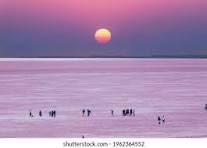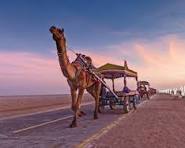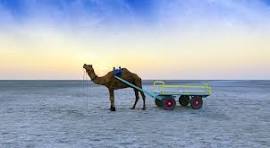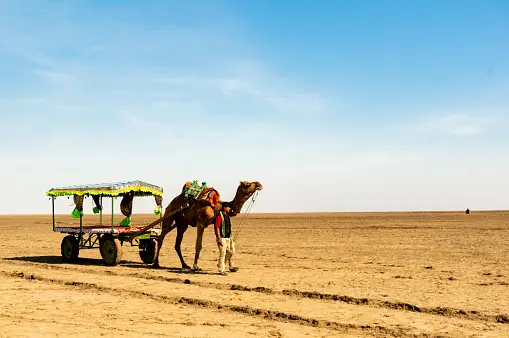




About Rann of Kutch
ABOUT RANN OF KUTCH:
Kutch is a place of regal grandeur, thriving customs, and fascinating heritage. It's no surprise that Kutch tourism comes as a vibrant mix of the region's greatest pleasures. The region's angelically superb artwork, which is improving daily, magnifies the charm of the area. The great Rann of Kutch, bounded by the Thar Desert on one wing and the Arabian Sea on the other, is like a massive tapestry that is overwhelmed with the hues of its crafts and cultures.
Away from the coast, the great Rann of Kutch is a sight that will leave you gasping for air. The miles-long expanse of emptiness is terrifyingly beautiful, with little watercourses and shrubbery which are homes to pink flamingos. A periodic tectonic movement has cut off the area's connectivity to the Arabian Sea, which was originally a vast shoal in the region. The marshes overflow with rainwater during the rains, and the floodplain stretches from the Gulf of Kutch westward to the Gulf of Cambay eastward. During the warmer months, the water evaporates, leaving behind a crisp substrate of white salty land.
Additionally, Rann of Kutch sightseeing will bring you closer to the region's celebrations, which fervently honour the long-standing customs. Your journey of the great Rann of Kutch will be memorable, vibrant, changing colours at each turn. You will learn a lot about and get to see beautiful sneak peeks of the locals' tribal way of life on this trip during the rann utsav. Additionally, you may browse the Kutch festival, their fairs and take advantage of the opportunity to discover their original artistic forms. If you can identify with their artistic personas, which are new, raw, and absolutely indigenous, the encounter will be much more cherishable.
The hub for Kutchi needlework, tie-dye, leatherwork, ceramics, bell metal art, and the renowned Rogan painting which is survived by the last existing professional family may be found in nomadic towns and villages geometrically designed with cylindrical mud huts.
Kutch's culture stands in stark contrast to its surroundings. The garments from the area are enhanced with Kutchi embroidery and Bandhani. Listening to traditional folk music is an everyday activity of all its residents. Garba and the Kutchi Gajiyo are essential components of festivities here, just like they are across the rest of Gujarat.
ABOUT RANN OF KUTCH FESTIVAL
One of India's most anticipated tourism festivals, Rann Utsav honours the White Desert's natural wonders as well as the region's artistic legacy. Gujarat's Chief Minister, Shri Narendra Modi had first conceived the idea for the Rann Utsav.
In the parched regions of Kutch, an abundance of various colours, exuberance of design, ostentation of heritage, and rhythmic fusion of music and dance combine to produce an incredible beauty that embodies the soul of the area. Every year, the Rann Utsav, a three-day celebratory fiesta bursting with warmth, vibrancy inspired by ethnic characteristics, is staged on the full-moon night of the winter season in the midst of the breathtaking and striking surroundings.
The festive event starts in Bhuj City and travels across the neighborhood. The whole stretch from Bhuj to Rann of Kutch feels extra terrestrial amidst the festivities. Events are held in Kutch by the Gujarat tourist board to highlight the diverse heritage of this important Indian region. People from all over the world have a one-of-a-kind chance to travel to Kutch and take in the authentic taste of the region thanks to this Utsav, which is being organised by Gujarat every year.
HOW TO REACH RANN OF KUTCH?
BY ROAD:
To travel to Kutch, there are both public and private transportation options accessible from Gujarat cities and even from Rajasthan. Taxis are also commonly available. You may even drive, and the best route to use to go to Kutch is National Highway 8A.
BY RAIL:
Your ideal option for taking the train to Kutch is from the Bhuj railway station. The distance from Bhuj to Rann of Kutch is around 82 kms. After reaching, you can simply catch a bus or rent a cab.
BY AIR:
Regular flights are available as Kutch is a well connected airport of India. Upon reaching Kutch, you can take buses or cabs to your destination.
BEST TIME TO VISIT RANN OF KUTCH
From November to February:
Rann of Kutch is best visited in the winter months. The desert springs to life in all its splendour and myriad shades during this time of year. The Rann of Kutch in October is the ideal time for sightseeing. The temperature is more enjoyable and mild during this season since the days are still warm yet comfortable.
Among the key winter activities are full moon evenings, desert clan cultures, dance performances, music performances, and bonfires across the sandy beaches and many others. During the winters, the moonlight reflecting off the pristine beach on such full moon evenings turns the area into an absolute wonderland. The Rann of Kutch Festival, which is held from November through February, is also believed to be at its finest during this time of year.
From July to September:
By the end of June, Kutch begins to experience rain, which lasts until September. Meanwhile, the Kutch Banni Grasslands bloom in the arid areas. Many migrating birds arrive in Kutch around this time, making it a beautiful spectacle for bird lovers. The Rann of Kutch is home to a number of sanctuaries that visitors may visit as well. Local species, such as the Wild Ass, can find refuge in the Kutch reserves.
From April to June:
The summer season runs from April to June. This time of year, the Rann of Kutch is not the best spot to travel because of the intense heat and high temperatures. However, summer nights are noticeably colder. The parched vistas do not provide any serenity to tourists at this time; therefore Rann of Kutch is not a place that summer tourists should visit.
WEATHER AND TEMPERATURE
WINTER SEASON
In the winter, the days are very comfortable, but after the sun goes down, the temperature seems to plummet down severely. During this time of the year, the weather in Rann of Kutch is noticeably pleasant and mild. Because of the Rann Utsav, which is held in Kutch from November to February, winter is the greatest season to travel there.
During the months of October through March, Kutch is open to tourists. The festival season further rejuvenates the atmosphere of the location, and the immaculate weather makes touring easier. The best time to visit bird viewing locations is at the start of winter.
MONSOON SEASON
By the end of June, Kutch has its first rains, which continue throughout September. Even while the rains are not intense, they nonetheless have the effect of cooling the environment. If you enjoy the sceneries of nature during rainy seasons and animal shooting then Kutch during the monsoons would be a paradise for the tourists! But a lot hinges on the accessibility of the roads, assuming that water logging situations do not impede it.
SUMMER SEASON
The summer months play a spoilsport in Kutch. Without any pity, the sun unleashes its wrath upon the earth. With temperatures reaching 50 degrees Celsius at lunchtime, it is unbearably hot. Kutch is not ideal in the summer season because of the desolate landscapes that lack any hint of greenery.
RANN OF KUTCH PERMIT
Given its closeness to the Pakistani border, the Rann of Kutch is a vulnerable region. As a result, permission to visit Rann of Kutch is necessary. The permission to visit Rann of Kutch may be acquired along route at the checkpoint at Bhirandiyara, a hamlet famed for its mawa, a milk-based confection, located about 55 kilometers (34 miles) from Bhuj. Permit reservations can also be made online. For various age groups, they offer various pricing.
- Rann of Kutch
16000
Day 1: Patan to Rani ki Vav
- Arrival at Rani Ki Vav from Patan Railway Station at 7 a.m.
- Depth of Rani ki Vav 27m
- 4 km to Patan Railway Station
- Patan Patola Heritage Museum located 3km from the station
- Night stay in the guest house
RANI KI VAV:
The first day starts early in the morning, near about 7 am. There are various tourist spots to step foot on. Rani ki Vav is a well sculpted step well situated in the walled town of Patan, 4 kilometers from Patan Railway Station. This is one of the best antique locations in India and among the top attractions in the Rann of Kutch packages to see while travelling to Patan since it is perched on the banks of River Saraswati.
It's possible that Rani Ki Vav has been the only Vav with such elaborate designs and extensive religious embellishments. A little gate just below the final step opens up to a 30-kilometre tunnel that acts as a link to the township of Siddhpur which is adjacent to Patan. The monarch, who constructed the step well during a moment of setback, formerly utilized it as an emergency passage, but presently it is barred by boulders.A celebration called Rani ki Vav takes place in December or January when attendees may indulge in traditional performances, delectable street foods, and window shopping.
PATAN PATOLA HERITAGE MUSEUM
A privately owned museum called Patan Patola Heritage is located in Gujarat, just 3 km from Patan Railway Station. It is the only facility of it’s like in the globe and one of the famed tourist attractions in Patan. The landmark of this museum is that it is located next to the Patan City Museum.
The year 2014 saw the establishment of the Patan Patola Heritage Museum, which is run by the prestigious Salvi family. A Patan trip would be incomplete without a visit to this museum to observe Patola silk spinning in reality.
You will have to stay overnight in Patan. Begin your journey early in the morning tomorrow so that you can spend some of your time with the alluring scenic locations and the diverse wildlife which constitute here.
Day 2: Patan to Patan
- Arrival at Modhera Sun Temple from Patan at 8a.m.
- Distance from Patan 35 km
- Travelling time 46 mins by car
MODHERA SUN TEMPLE
Modhera Sun Temple, 35 kms away from Patan, is a historic Hindu temple situated in Modhera hamlet in Gujarat. It is a renowned historical site in India, located on the Pushpavati River banks. Mahmud Ghazni pillaged the temple, and still its spectacular architecture has endured.
The temple is a designated site under the Archaeological Survey of India and is not currently used for worship. In 2014, it was included on the list of UNESCO World Heritage Sites. Every year in January, the Modhera Dance Festival is held close to the Sun Temple. The three-day event is on the same weekend as the well-known Gujarati holiday known as "Uttarayan."
INDIAN WILD ASS SANCTUARY
The Indian Wild Ass Sanctuary is a national sanctuary located in the Little Rann of Kutch, Gujarat. It is situated 238 kilometers from Bhuj, and 320 kilometers from the Great Rann of Kutch. It is the one of biggest sanctuaries in Gujarat and the finest site to visit near Ahmedabad for wildlife aficionados. It is also familiar by its other name, the Wild Ass Wildlife Sanctuary.
Jeep safaris are among the greatest things to do in Rann of Kutch if you want to see most of the animal reserve. The sanctuary has two primary entry points: Dhrangadhra and Bajana. Most visitors want to visit the Sanctuary at Range Bajana since it is where they can see migrating birds, although Dhrangadhra town also has adequate lodging, eating, and transit options.
Expeditions to the Bajana Range by jeep are offered at stipulated time frames in the morning and evening. Private jeeps can also be rented. Safaris must be accompanied by a sanctuary ranger.
